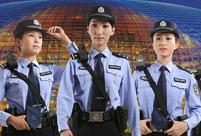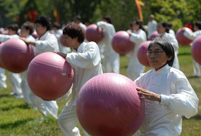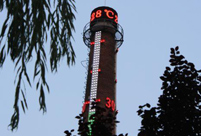 Amphibious armored vehicle unit conducts open sea drill
Amphibious armored vehicle unit conducts open sea drill
 Water relay in Henan
Water relay in Henan
 Ethnic culture feasts eyes of travelers
Ethnic culture feasts eyes of travelers
 80 security dogs assembled in Nanjing police dog training base
80 security dogs assembled in Nanjing police dog training base
 Graffiti artists paint on street walls in Xinjiang
Graffiti artists paint on street walls in Xinjiang
 Story of ceramic artist Zhang Lingyun
Story of ceramic artist Zhang Lingyun
 Magic summer night dream in Hongyuan
Magic summer night dream in Hongyuan
 Incredible creatures in headwaters drainage region of Lancang River
Incredible creatures in headwaters drainage region of Lancang River
 The future of rock n' roll seen in young rockers in China
The future of rock n' roll seen in young rockers in China
 Magnificent Yanziya Cliff
Magnificent Yanziya Cliff
BEIJING, Aug. 11 -- The Chinese government has steered its urbanization drive into the fast lane with new measures to clear major hurdles.
Government departments have coordinated their efforts in the past few weeks on aspects that have been holding back urbanization, including the household registration (hukou) system, housing renovation and township development.
RAILWAY LAND DEVELOPMENT
The State Council, the Cabinet, on Monday unveiled policies to support the efficient use of land surrounding railway stations and lines, encouraging railway operators to build stations, lines and engage in property development.
The new measures aim for benign interactions between railway construction and urban development, promoting sustainable railway development and urbanization.
Hu Cunzhi, vice minister of land and resources, said development of railway land is a new pattern in urbanization and the ministry will give it full support.
In March, China's urbanization plans for 2014-2020 were released. By 2020, China's ratio of permanent urban residents to total population should rise to about 60 percent from 53.7 percent at the end of 2013, bringing large demand for investment in infrastructure, public services and housing.
Last Monday, a cabinet circular promised financial support for slum renovation, considered key to urbanization. The government has set the goal of subsidizing the rebuilding of 4.7 million housing units this year.
HUKOU REFORM
Late last month, the State Council announced an overhaul of the hukou system, including equalizing rural and urban status, differentiated settlement schemes for migrant workers and the expansion of basic social services for all residents.
About 100 million people will settle in towns and cities by 2020, and the government will remove hukou limits in townships and small cities, relax restrictions in medium-sized cities, and set qualifications for big cities.
"These changes are a big step in breaking down institutional barriers between urban and rural lives," according to a research note from HSBC chief China economist Qu Hongbin.
It will also help China achieve its urbanization target in a sustainable manner and maintain growth by lifting productivity, Qu said.
Soon after release of the guideline, seven ministries announced that they would include more settlements in a list of national level key townships to receive special support from the government. The new list has 3,675 townships, nearly double the 2004 list. The development of those townships should be prioritized by local authorities.
"In the past decade, a large number of townships emerged," said Feng Kui, a researcher with the National Development and Reform Commission, the top economic planner.
The new adjustment adopts higher requirements, including population, growth potential and service functions, and will help raise the overall quality of urbanization, Feng said.
 Beijing policewomen posters become a hit
Beijing policewomen posters become a hit Armored regiment trains on the sea
Armored regiment trains on the sea Children spend 'Father's Day' with dads at work
Children spend 'Father's Day' with dads at work 'Pan Da' appear in Shanghai World Financial Center
'Pan Da' appear in Shanghai World Financial Center Champions take selfies on podium
Champions take selfies on podium National Fitness Day celebrated around China
National Fitness Day celebrated around China Traditional culture colors summer vacation
Traditional culture colors summer vacation Young athletes fighting for their dreams
Young athletes fighting for their dreams 68 meters high thermometer in Shanxi, called ‘fighter’ of thermometers
68 meters high thermometer in Shanxi, called ‘fighter’ of thermometers 22-year-old veteran travels around China
22-year-old veteran travels around China
 Night scenery of pagoda forests
Night scenery of pagoda forests China suffers from hot summer
China suffers from hot summer 48 hours after super Typhoon Rammasun
48 hours after super Typhoon Rammasun German pianist plays mid-air ‘magic carpet’ show over Munich Airport
German pianist plays mid-air ‘magic carpet’ show over Munich Airport
 China's manned deep-sea submersible conducts dive in Pacific Ocean
China's manned deep-sea submersible conducts dive in Pacific Ocean
Day|Week|Month